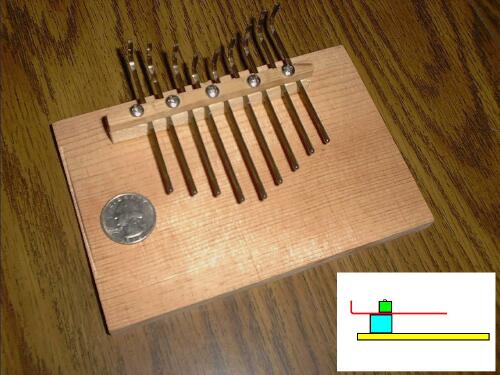
A kalimba using bobby-pins as twangers.NOTE: 10 additional photos and a sound sample of this instrument are available. Click here for information.
This extremely simple kalimba is a real instrument --- playability is great. Tone and volume is surprisingly good too. I made it to see just how simple a kalimba can be made. It's construction needs little or no description -- everything can be seen in the photo.

I made this kalimba to have the same scale as a bagpipe
(9 notes). There is no sound-box, only a "sound-board".
The type bobby-pin used is one size bigger than "regular"
bobby-pins --- they are about 2-5/8" long & a small bit wider
than 1/16". I used Goody brand, product number 01457.
- Bend each bobby-pin to right angles (careful - they can break).
- With each of the pins, cut off all but a half inch of the side
with the bend. (I dulled the jagged ends with a grinder)
- The soundboard is a piece of 3/16" or 1/4" solid or plywood,
4" by 6". Absolutely nothing here is critical.
- I used a piece of 3/8" square by 4" long hardwood that the
twangers rest on. This piece is glued to the soundboard.
- For the piece of wood that pushes down on the twangers, I used
hardwood - 1/4" square by 4" long. Five evenly spaced 3/4"
woodscrews securely clamp the twangers between these two
pieces of hardwood (three screws didn't hold it good enough).
Make sure that the front edges of the two hardwood pieces are
flush.
- The only awkward thing is holding and positioning the nine
twangers while tightening the five screws. My advice is to
not tighten the screws too tight at first --- once the
twangers are positioned properly, then tighten them.
I also found it a help to clamp the instrument in a vise
while installing and tuning the twangers.
- Tuning is easy, but may require a slight temporary
untightening of the screws.
Do not remove the plastic tips of the bobby-pins as they make
comfortable twanger ends.
It took me a bit less than a half-hour, start to finish, to
build.
I made a simple box for an experiment, but it didn't add much
volume, so went back to just a single board.
My first bobby-pin kalimba had the twanger base mounted along
the narrow edge of the soundboard, but the tone of the shorter
twangers was not good. By instead mounting the twanger base
along the wider edge of the soundboard (and about 3/8" in from
the edge), the tone improved immensely.
This is a good tuning:
ti so mi do * re fa la do'
| | | | | | | | |
| | | | | | | | |
| | | | | | | |
| | | | | | |
| | | | | |
| | | | |
| | | |
| | | * = a full step
| | below "do"
|
The short length of the bobby-pins more or less limits what key
the instrument can be tuned in -- Optimum sound/tone in my case
(where the lowest note uses almost the full length of the
bobby-pin) was when the instrument was tuned in the key of G but
considering that this simple kalimba will likely never be played
in a band, the key is relatively unimportant.
Fun little thing!
I made another such instrument, but used regular sized (smaller)
bobby-pins instead. it worked fine too --- had a different, but
also pleasant tone.
Dennis Havlena - W8MI
Mackinac Straits, northern Michigan
10/14/2001
Click here to access my webpage